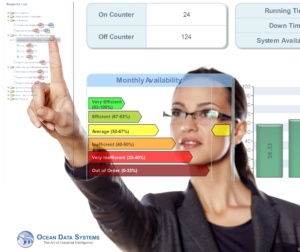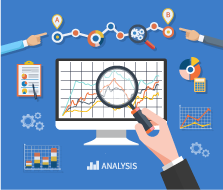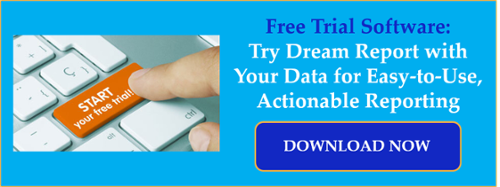Today’s automation professional is tasked not only with continuous improvement of the automated processes he or she is responsible for, but also doing it with less resources and a lower budget. Labor is expensive and over-tasked.
With all of the core business tasks an engineer faces today, they simply may not have the time to sift through the all of the options available in the marketplace for gathering “business intelligence”.
A key buzz term used in the front office of many companies, business intelligence needs on the automation side of an enterprise are centered around Industrial applications. While business intelligence tools are great at dealing with counts and currencies, automation processes need that and more.
In this blog post, we’ll discuss the three main reasons to have a business intelligence solution and, also, the three key ways that Dream Report delivers nicely on the greater needs of hybrid industrial/business data analytics requirements to provide business intelligence for making key decisions regarding a process to save time, money and expenses.

First of all, though, before we look at the how, let’s consider why you need business intelligence in the first place?
There are three main reasons. And it is likely that one or maybe more of them is the reason you’re reading this blog post right now. To truly understand the real value business intelligence information will deliver, in addition to your immediate need, let’s review the needs of your entire organization. It is likely that they will all be involved in specifying, using or approving a plan to implement a business intelligence solution for your operation.
The three key reasons you would need to implement an Industrial Business Intelligence Solution:1. There’s information you don’t already have that you need to run your business.
If you don’t have this, then you aren’t able to be in business. This is required information, such as compliance information, driven by regulations and best practices. Required information is rarely already in the form you really need to drive continuous improvement.

2. The ability to maximize the context of your data.

This means having the ability to provide month to month, year to year or even batch to batch comparisons for driving continuous improvement. This data, and the context to drive decisions is what we call your desired information.
Essentially, it’s the information you’d ideally like to have in order to run your business better. This is the key performance information pertaining to quality, quantity, cost, agility, improvements etc. and the context to know how it is changing from one period to the next.
3. Analysis tools to better understand your data.
If you had ready access to perform ad-hoc analyses on your process, you’d be able to more readily react to day-to-day changes and empower your workforce to access and analyze their own information, when and where they need it.
 You don’t typically know what you need exactly until there is something to investigate. And, as with the timeless adage, “Anything that can go wrong, will go wrong”, it is the information that you don’t currently have access to that you’ll likely need the most and have to scramble to attain.
You don’t typically know what you need exactly until there is something to investigate. And, as with the timeless adage, “Anything that can go wrong, will go wrong”, it is the information that you don’t currently have access to that you’ll likely need the most and have to scramble to attain.
It’s also important to understand that different roles have different information and delivery requirements. Some users will want real-time dashboards, others will want reports. At some point, everyone will want some form of ad-hoc access to perform their own data investigations without requiring an act of Congress to achieve it (or, minimally, having to involve IT).
So now that we understand a little more of the why, let’s look at the ways Dream Report can deliver on these needs.
1. Required Capabilities for Drilling into Business Intelligence Reports
 Regulations and best practices drive this category. These are reporting requirements, often imposed by government agencies with guidelines and strict penalties in their absence (i.e. if you don’t have it, you’re going to pay big dollars).
Regulations and best practices drive this category. These are reporting requirements, often imposed by government agencies with guidelines and strict penalties in their absence (i.e. if you don’t have it, you’re going to pay big dollars).
In fact, it is this category that’s been a primary motivation in the reporting marketplace since the early 1990s. Many solutions to address this requirement take the form of repurposed business tools, with significant system integration and customization efforts required to meet the end results that are needed.
However, since these are these are “must have” reports, cost becomes secondary to availability.
There are examples in virtually every industry. EPA and DNR guidelines impact users in Water, Wastewater, Power and Chemicals industries among others. FDA impacts Food, Pharmaceutical and Biotech industries. Leeds, EPBD and Energy Star impact the Building Automation space. Numerous regulations and best practices drive the need for automated reporting of continuous and batch processes within such industries.
There are specific challenges when adding regulatory reporting to a business intelligence application. Reports typically get specified at the end of a project, when all of the raw data is then available and, unfortunately, when time and money are starting to run low.
The risks involved with implementing a solution at this point in the process are high. A such, the chosen solution needs to have the greatest opportunity for success, the lowest Total Cost of Ownership (TCO), be the easiest to learn and apply, and be designed for the specifics of the defined task.
This combination of high cost and project completion risk has influenced the market to avoid reports in the past. In the situations described, such reports are just too hard to get, time consuming and expensive to easily justify to the decisions makers writing the checks.
2. Flexible KPI Delivery via Dashboards or Reports
While this second category is commonly delivered through dashboards, many times traditional reports are beneficial for long term records. When striving for continuous improvement, you’ll want to generate KPIs unique to your specific business and to have the flexibility to change them, adapt them, and deliver them with the context to make them actionable. And you’ll want to do all of those quickly and easily so that it’s not a chore. What you don’t want is for your business intelligence solution to be become the property of your IT professional, since you won’t be deriving nearly as much value when IT is the gatekeeper to your KPIs.

The process of getting reports and dashboards is often one of writing a specification, scheduling the work, seeing the results days or weeks later and iterating to get the result you expect. This is a time consuming and costly approach and, unfortunately, many solutions for dashboards are just too hard to justify.
Also, creating the best context (i.e. surrounding your KPIs with all the other data that makes them actionable) takes processing power and isn’t always something you’ll want to wait for with interactive tools. You have more important things to do than watch progress indicators. This is where automated capabilities are so important, providing the ability to set up complex statistics and schedule their delivery to a KPI report or dashboard automatically.
3. Ease-of-use in Seeking Actionable Information in the Solution
It’s a safe assumption that you have loads of data in many systems, both industrial and on the business side. And you have users in your organization that need to access that data - when they want it and where they want it.
 They need to select tags, dates and times and interact with that data quickly and easily. And they may want to export it to Microsoft Excel, or copy it to the clipboard for use in other applications. Properly implemented through the use of standard web browser technology, your users can have the equivalent of a self-service portal where they can log in from any device (PC or mobile), and any browser and have access to all of their data.
They need to select tags, dates and times and interact with that data quickly and easily. And they may want to export it to Microsoft Excel, or copy it to the clipboard for use in other applications. Properly implemented through the use of standard web browser technology, your users can have the equivalent of a self-service portal where they can log in from any device (PC or mobile), and any browser and have access to all of their data.
That self-service portal can be used for KPI development and review, or it may be used for ad-hoc analysis and troubleshooting.
So, to review, when you’re evaluating solutions that deliver “industrial” business intelligence, make sure they can deliver on all three aspects of information delivery and you’ll be addressing the complete picture, delivering the greatest value to everyone in your organization.
And, it can also be helpful to consider the following five fundamental information requirements (doing these well will maximize your ROI):
- The ability to turn raw data from ANY data source (even data combined from various data sources) into the KPIs needed to match user requirements.
- The ability to deliver your KPIs with enough context to make them immediately actionable. How does this KPI compare to last batch, last week, last year, etc. or other variables that help guide a decision.
- Automatic generation of KPIs and Context saves time and money. Your team is should be focused on evaluating results, not generating them.
- Generating KPIs are one thing. Making sure they are reviewed and acted upon is another. That’s where automated delivery comes in, via Email, and local or FTP file transfers. Portals are great, but having portals and email and file delivery is better for holding users accountable.
- Finally, when a KPI looks "off" for some reason, you’ll need the ability to drill into your data, call up associated data and have ad-hoc access to all the necessary information to troubleshoot and analyze the problem. That also includes being able to export the data for further analysis in other software, or for sharing with other individuals.
Want to try Dream Report with your own process data? Download the free trial.



